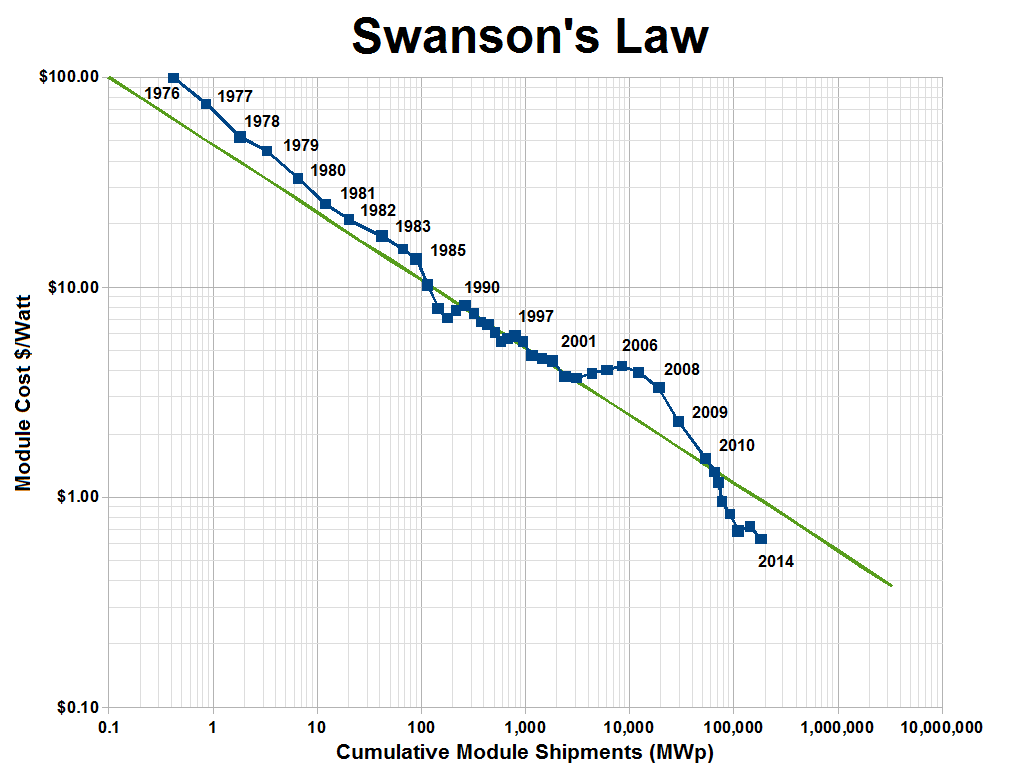Notes from a seminar with Ray Kurzweil
I had the opportunity to attend the Abundance 360 conference a few weeks ago in Los Angeles. I came away with some interesting insights and predictions about the future trends in technology from the various speakers.
One of the most interesting sessions was a two-hour discussion and Q&A session with the author, inventor and futurist Ray Kurzweil. If you aren’t familiar with Mr. Kurzweil’s work, he is well-known for many future predictions that have come true. Some analysts have studied his work and note that he has had an 86% success rate on his predictions over the past few decades. Many more of his predictions are still well into the future but appear to be on track to coming true. He doesn’t make calls on who will win the Superbowl, but focuses more specifically on trends in science and technology, where the rate of development progresses at a measured rate.
In the investment business it helps to have a crystal ball, or at least have an understanding of what disruptive changes are around the corner. I was definitely keen to hear what he had to say and learn how he has had such an impressive track record at predicting the future. During his talk he stated his predictions on the rate of progress of everything from artificial intelligence, medical technology and solar power.
- When will we see true artificial intelligence?
- How long will a child born today live?
- Will solar power become an inexpensive and dominant source of electricity?
- What are the implications of themes like these playing out in the next few years and decades?
Mr. Kurzweil has predicted many future trends that have come true within a year or so from the date that he originally made the prediction. He has predicted everything from the demise of the Soviet Union to when a computer would be able to beat the best chess players in the world.
How does one individual make such bold predictions that seem to almost always come true? During the seminar, Mr. Kurzweil explained the rationale on how he makes his predictions, and it is actually a fairly straightforward process. It all comes down to the fact that it is difficult for people’s minds to think in exponential terms.
A simple example of exponential growth is folding a piece of paper. If you fold a piece of paper three or four times, the difference in thickness is barely noticeable. If you could theoretically fold a giant piece of paper 40 times, how thick would it be? The answer is that at 20 folds it would be about the length of a football field, and at 40 folds it would be the equivalent height to where satellites orbit the earth. Examples like these are difficult to picture, as they eventually become too far-fetched to even comprehend. It obviously isn’t possible to fold a piece of paper enough times to reach outer space. However, this exponential growth effect does show up in many other areas of technology where the physical limitations are less constraining.

Image credit: ed.ted.com/lessons/how-folding-paper-can-get-you-to-the-moon
One of the most well-known exponential growth models is Moore’s Law, which stipulates that the price/performance of computer chips will double every two years. This rule has held true ever since Gordon Moore came up with this prediction in 1965. Computer chips are still improving at roughly this rate, although some suggest that the rate has slowed and now it takes about two and a half years for every doubling of processing performance. While computer chip manufacturers are reaching the limits of how small and densely packed they can make their silicon chips, new and even faster technologies are under development that will eventually replace silicon chips and are likely to prove that Moore’s law continues to hold.
In the past 100 years, computers have progressed from basic switches, relays and vacuum tubes to transistors, and finally to the integrated circuits or silicon chips that have been the norm since the mid-1970s. I think back to my first laptop and recall that it was a massive brick that weighed about ten pounds, had a 1 gigabyte hard drive, a painfully slow processor, and the battery lasted about 30-40 minutes. By comparison, my new iPhone fits in my pocket, has 128 gigabytes of memory, a supercomputer processor, and the battery lasts for days. Comparing the growth in power and performance of these two devices, nearly every aspect of my new phone is 100 times better than my laptop in the span of less than two decades.
One of Ray Kurzwiel’s notable predictions was regarding the sequencing of the human genome. When the project first started, it took billions of dollars and seven years to sequence only the first 1% of the human genome. His detractors argued that it would take hundreds of years and billions more dollars to complete the task at the rate they were going. What the skeptics didn’t take into account was the fact that in the seven-year period, most of the progress was made in the seventh year and they were doubling the rate of genome sequencing about every year while the cost was dropping by half. Ray made the prediction that they would be done sequencing the entire genome in less than seven years after they had completed the first 1%. His rationale was that the rate of progress and improvement of sequencing technology was increasing at an exponential rate, and projecting out the continued progress, they were only seven more doublings away from completing the task.

It now takes a few weeks and costs a few hundred dollars to sequence a person’s genome. In fact, private companies offer this service online and can send you a kit to send back your DNA samples through overnight shipping. One of the market leaders in this sector is the company called ‘23andMe’, named for the 23 chromosomes in the human genetic make-up.
As genome sequencing becomes the norm, it is sure to unlock many new medical advances such as customized drug treatments, as well as preventative programs such as modified diets and lifestyle changes to prevent diseases before they even occur. Knowing exactly what diseases you are genetically predisposed to potentially raises some interesting ethical questions. I’m sure that life insurance companies are looking at this technology as a way to improve their actuarial and underwriting processes.
Photo credit: 23andme.com
What other sectors are experiencing exponential growth?
Another sector that is experiencing exponential growth and is related to computer chips is the growth in internet network capacity. Although it may not seem like this at certain times of the day when your browser won’t load or your computer crashes, computer network capacity is increasing at a rate similar to computing power, and doubling every few years. Companies like Google and Facebook have initiated ambitious projects to connect the entire planet with high-speed wireless access at low cost using such things as solar-powered high-altitude drones and weather balloons that would stay aloft for weeks at a time to allow wireless internet access to reach every corner of the earth. While it is an altruistic goal for these companies to provide free high-speed internet access to the world’s poorest regions, their businesses would also benefit in the long-term by bringing another 5 billion people online. That is a lot more Google searches, Facebook ‘likes’ and advertising clicks in the coming years. Perhaps these so called ‘moonshots’ that these companies are spending money on aren’t such far-fetched projects after all, but calculated bets to simply grow their markets and users.
Mr. Kurzweil’s also made an interesting prediction on solar power that has broad implications for the energy sector. He predicts that in the next 15 years, solar power will be the dominant form of electricity generation globally. Globally, solar power makes up only about 1% of electricity generation capacity at the moment. This seems like a miniscule amount of progress given that the photovoltaic effect was discovered in the mid-1800’s and solar panels have been a commercial form since the 1950s. Comparing the 1% installed base of solar power to the global installed generation capacity of coal and natural gas at 41% and 22% respectively, would lead one to believe that these sources will hold their dominant positions for decades to come. Assuming linear growth, this would be the case. But applying the assumption that the growth of solar power is exponential and that the trend will continue exponentially as costs drop, the basis for his prediction becomes evident. New installed solar capacity is currently growing at a rate where it is doubling and costs are dropping by half about every two years. If this exponential growth continues to hold true, we are approximately 7 more doublings away from solar power reaching a level where it dominates the market for electricity generation. I’m sure that you have done the math in your head and see that seven doublings at two year intervals works out to about 14 years, which is right in-line with Mr. Kurzweil’s prediction. This phenomenon is relentless and growth interpolations one way or another only modify the diming of the outcomes moderately. It is no longer a question of if this will take place, it is now just a question of when.

Solar power is following a trajectory called ‘Swanson’s law’, which is illustrated in the chart below. According to this law, the cost of solar power is dropping exponentially as module shipments increase exponentially over time. While the trend isn’t a perfectly straight trajectory, the trend appears to be holding true and even accelerating. What does this mean for things like billion dollar liquefied natural gas projects that have multi-decade project lives? Will the world even need the natural gas by the time they are built?
He also predicted that by 2029, computers and artificial intelligence systems will have developed to a point where a computer can pass a ‘Turing test’. If you aren’t familiar with the term ‘Turing test’, it basically means that an artificial intelligence system becomes so advanced that a human will not be able to tell whether they are interacting with a computer or an actual person. The recent science fiction film ‘ex machina’ tells a dystopian tale of artificial intelligence gone wrong.
Image credit: wikimedia.org/wikipedia/commons/2/29/Swansons-law.png

Image credit: Screenshot from the film 'ex machina'
Mr. Kurzweil also suggested that a child born after the year 2000 can realistically expect to live past 100. Advances in medical technology in areas such as genetic analysis and drug development, mean that his prediction could easily happen. Researchers have also adapted 3D printing technology to create live organs that have been successfully implanted into primates. Kurzweil predicts that by 2033 essentially all forms of cancer will be cured and nearly all viral diseases will have a cure. He also predicted that by 2048, a cryogenically preserved human would be able to be brought back to life. One of the quotes from his talk was “will you live long enough to live forever?” Meaning that as people live longer, they will benefit more and more from future medical advances and live even longer. While actually living forever is unlikely, people may start living past 100 or even 120 years old in the not too distant future.
These topics are definitely worth further examination and will likely be discussed in future blog posts as these trends progress. One thing that we must all be prepared for is disruptive change to the status quo.